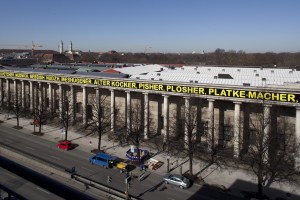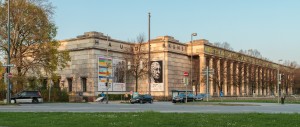A provocative installation in Munich
The “Haus der Kunst” (House of Art), praised by the Nazis as “Germany’s most beautiful building,” has now been bedecked with banners bearing Yiddish slang. In a refreshing display of chutzpah, a Jewish artist from New York, Mel Bochner, staged the “Joys of Yiddish” event in Munich, of all places, the city the Nazis considered the “capital of the Movement.”
The classicist columns of the gallery opened by Nazi bigwigs in 1937 are festooned with banners bearing slogans. The Nazis, too, used banners – banners denouncing Jewish or pacifist artists: “A Mockery of German Womanhood,” and “An Insult to the Heroes of the World War,” announced the walls of the “Degenerate Art” exhibition in 1937 in judgment against the expressionist, Dadaist, and surrealist works that the Nazis had put on display to denounce modern art in general.
The color yellow
The banners of today feature yellow text on a black background. Wasn’t yellow the color of the star that Jews were forced to wear under the Nazi regime? It was the same yellow that the Dresden linguist Victor Klemperer wrote “still signifies plague and quarantine today and which, in the Middle Ages, was the identifying color for Jews, the color of envy and of bile in the blood, the color of suspected evil…” How does it now come to pass that the color of “evil” suddenly stops being a color, emerges from the background, and flows into the shapes of letters, and becomes a symbol, and from this symbol language emerges, and that language is … Yiddish?
This is the concept of the 73-year old Mel Bochner. He had “constructed” the two-color banners for the Spertus Institute of Jewish Studies in Chicago using Yiddish words that have entered into American English. KIBBITZER – “know-it-all”, NUDNIK – “pest”, CHAZZER – “pig”, NEBBISH, MESHUGENER… Bochner has linked the “color of the perpetrators with the language of the victims.”
Bochner is considered a key originator of “conceptual art,” in which artistic work is “dematerialized” in favor of the underlying idea, and thus takes shape in the mind of the beholder in unusual perspectives and unmediated associations. Thus, Bochner’s “The Joys of Yiddish” is reinvented in the context of the National Socialist “Art Temple.” Placed in an environment that its creator had not originally considered, it evolves into a self-fulfilling pro-ject. It transforms the monumental showpiece of the Third Reich into a paradox of art history. Hitler, whose own artistic ambitions were failures, had laid the cornerstone for this building himself in 1933; he envisioned it as a home for “healthy, purely German art.”
Political work vs. political art
For observers today, it is interesting that the meanings of some of the words in Yiddish, which emerged as a variant of Old High German about 1,000 years ago, are readily apparent. Take for instance, “meschugge,” which is used synonymously with “crazy” in German today. The linguist Gertrud Reershemius confirms that Yiddish words have enjoyed “increasing popularity” since the 1980s and have become “permanent fixtures in the prose of journalists.”
Bochner himself would like us to understand his work as “political work,” but not as “political art,” as he emphasized in a lecture at the NYU Institute of Fine Arts in 2007. Referring to his “Thesaurus Paintings”, he stated “Whether in the public or private domain, my recent work attempts to confront the ideologies and hidden agendas of language. Because as recent history has painfully taught us, all abuses of power begin with the abuse of language.”
Sigrun Borstelmann is a Munich based author and journalist

